- New Products
- Exclusive Gear
- Bushcraft Gear
- Containers
- Cooking
- Fire
- First Aid
- Food Gathering
- Knives & Tools
- Knife Collectors Corner
- Light
- Logo Gear
- Misc. Items
- Navigation
- Packs, Pouches & Bags
- Personal Care
- Repair Gear
- Shelter & Protection
- Signaling
- Urban Survival
- Water
- Writing Gear
- John's Books
- Bargain Bin
Keep That Bug-Out Vehicle Rolling
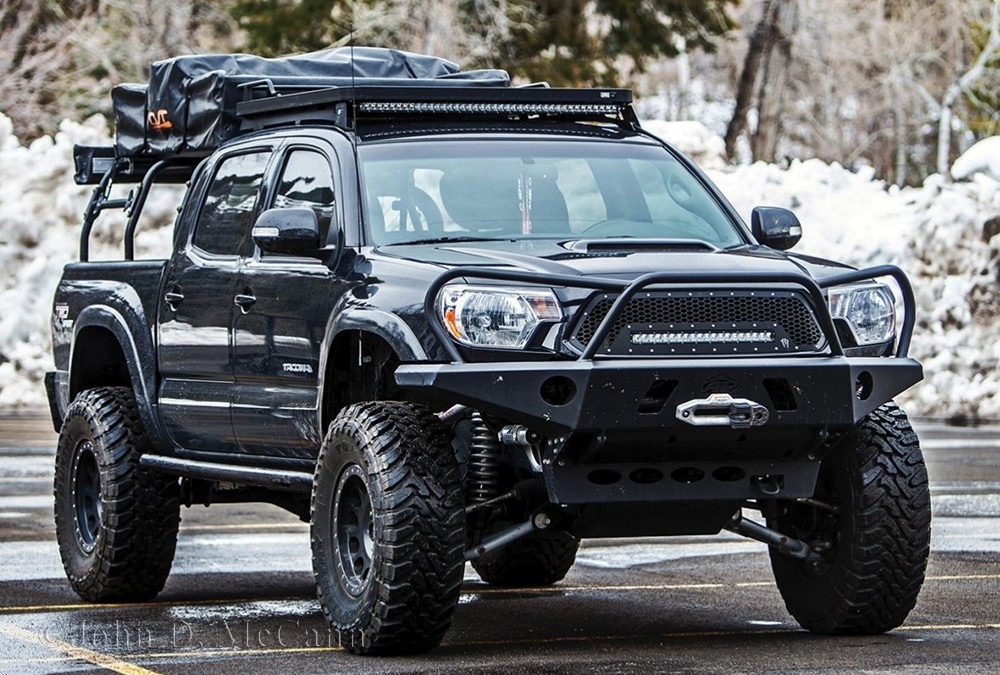
We often talk about Bug-Out Vehicles, especially in regard to what type of vehicle to have. Obviously, that choice will be yours, but no matter what you decide on, you will need to keep it rolling.
Safety Equipment
The first thing I think of is safety. There are various types of safety equipment that are part of a vehicle such as anti-lock brakes, airbags, etc. But you should have at least two additional in the event of an accident or a fire.
The first item should be a device that will allow you to cut your seat belt and break out your window from inside. I prefer the LifeHammer which provides both functions. I keep one mounted on the ceiling between the sun visors so that it can be reached by the drive and the front passenger.
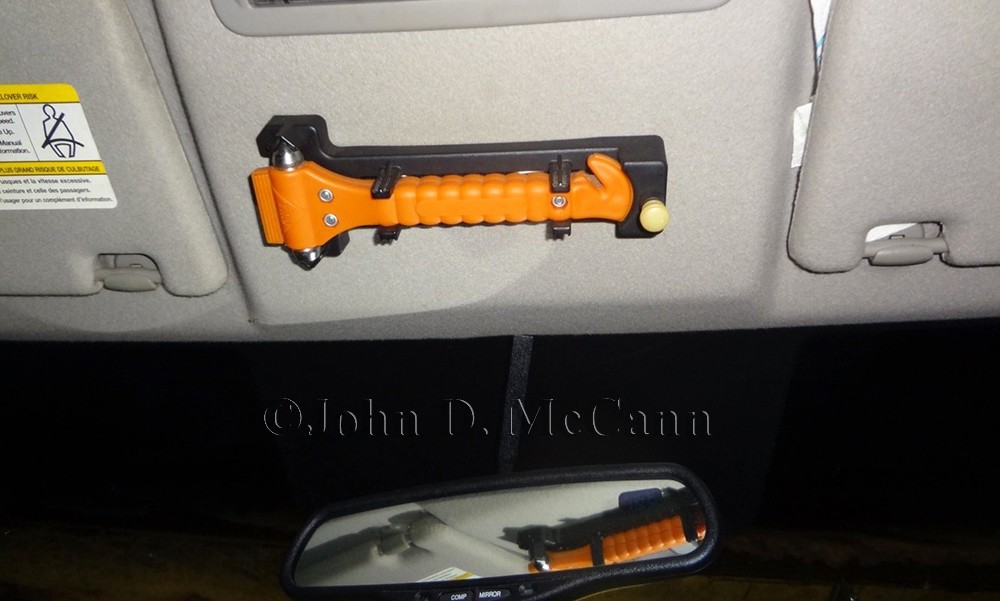 This shows the LifeHammer, as described in the above text, mounted on the ceiling between the sun visors,
This shows the LifeHammer, as described in the above text, mounted on the ceiling between the sun visors,
so it can be reached by both the driver or right front passenger.
You can also carry an auto-punch which will allow you to break the window from inside, but it must be accessible in an accident, so don't hide it in the glove compartment. There are also mini seat belt cutters which can be attached to a key ring.
Another item I like to have in every vehicle is a fire extinguisher. It can come in handy if you have a fire, and like other safety equipment, must be easily accessible when you need it. I have always mounted an ABC fire extinguisher to the center hump of my vehicles so it can be accessed quickly when needed. As a tip, I never use the plastic mounting brackets that usually come with the fire extinguisher, but get a good metal mounting bracket to make sure it stays in place.
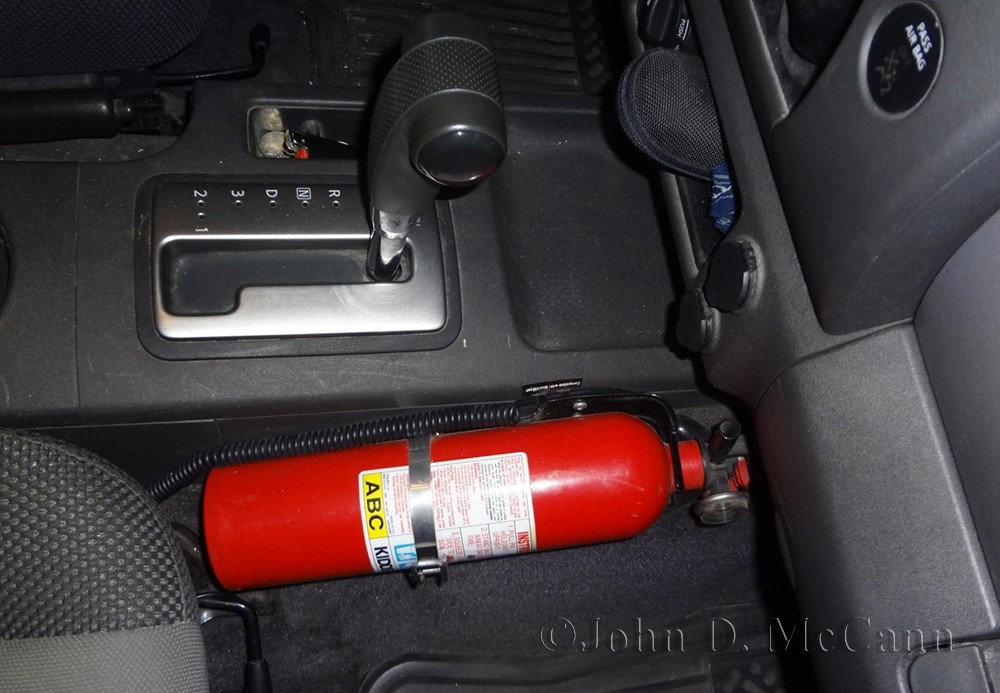 A fire extinguisher should be mounted where you can readily get to it when needed.
A fire extinguisher should be mounted where you can readily get to it when needed.
Repair and Recovery Equipment
A good set of tools that will allow you to repair your vehicle should be kept on hand. Some spare parts, as well as duct tape and cable ties, just might help you keep the vehicle going.
If you have an SUV, pick-up, or van, you might consider carrying a come-along and some nylon tow straps. A come-along is a device that actually functions as a hand powered winch and can be used in conjunction with the nylon tow straps to pull yourself out of a ditch, or if you get stuck in the mud. In conjunction with these, if you have attachment points on your vehicle, you might consider some screw pin shackles. If you carry chains a chain hook is also handy.
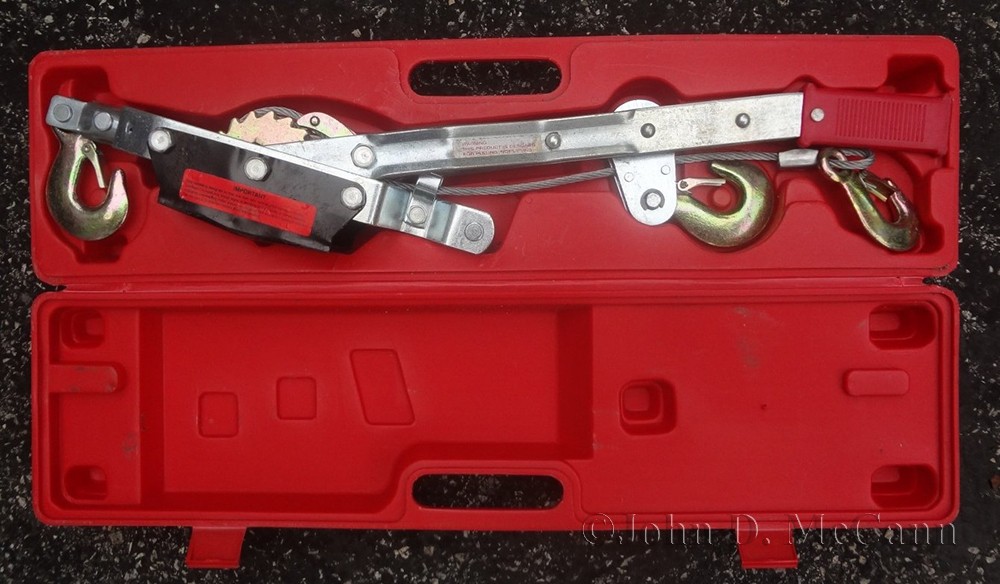 The above photo shows a come-along that the I keep in my truck. It comes in a heavy-duty plastic case that snaps
The above photo shows a come-along that the I keep in my truck. It comes in a heavy-duty plastic case that snaps
shut and keeps it from banging around.
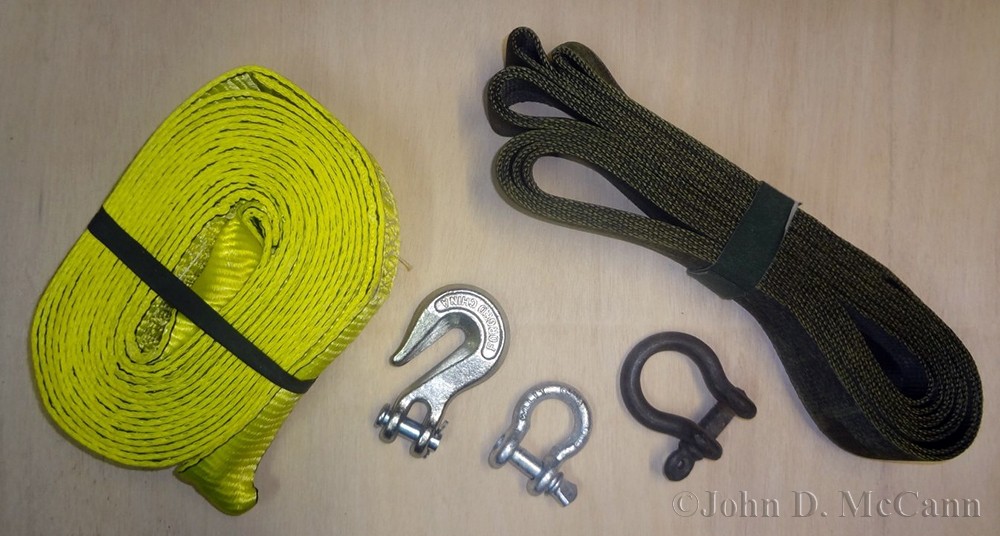 If you carry a come-along, you should also carry some nylon tow straps and some screw pin shackles.
If you carry a come-along, you should also carry some nylon tow straps and some screw pin shackles.
If you drive a vehicle that is raised higher off the ground than normal I highly suggest that you carry a high-lift jack. This allows you to jack the vehicle up, which cannot be done with a normal jack.
I have the Hi-Lift "Xtreme" which also allows you to use the jack as a come-along. I always like multi-functional items.
 The above photo shows the Hi-Lift "Xtreme" jack that I purchased for my vehicle.
The above photo shows the Hi-Lift "Xtreme" jack that I purchased for my vehicle.
The Hi-Lift jack comes with an additional large heavy-duty base that the bottom of the jack fits into. This helps distribute the weight on a soft surface, especially when off-road. If you don't have this plate, you should carry a thick piece of wood for the same purpose.
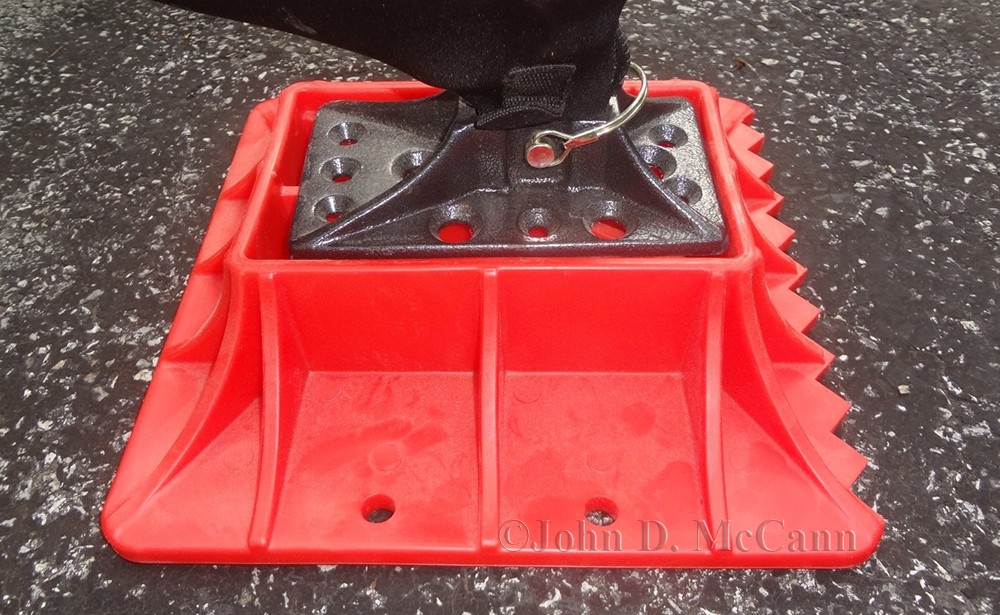 This shows the Hi-Lift Off-Road Plate to help distribute the weight when used on a soft surface.
This shows the Hi-Lift Off-Road Plate to help distribute the weight when used on a soft surface.
You might also consider an occasion when you have to cut a lock or a chain link fence, etc. Of course I'm not advocating breaking the law, but you might need to get access to an area as a result of a detour, etc.
For this purpose, a pair of fence pliers or bolt cutters might come in handy. I have a pair of each in the truck, and the bolt cutters have handles that fold in half for ease of storage.
I also recommend a sturdy hacksaw, as well as a good solid pry bar. A minor fender bender can push a fender against a tire and a pry bar comes in handy to pull the fender away from the tire, or other purposes.
Having the tools to repair your vehicle and assist you in getting out of a tight spot, without requiring help from others, may be the difference between you continuing on your way with your vehicle, or without.
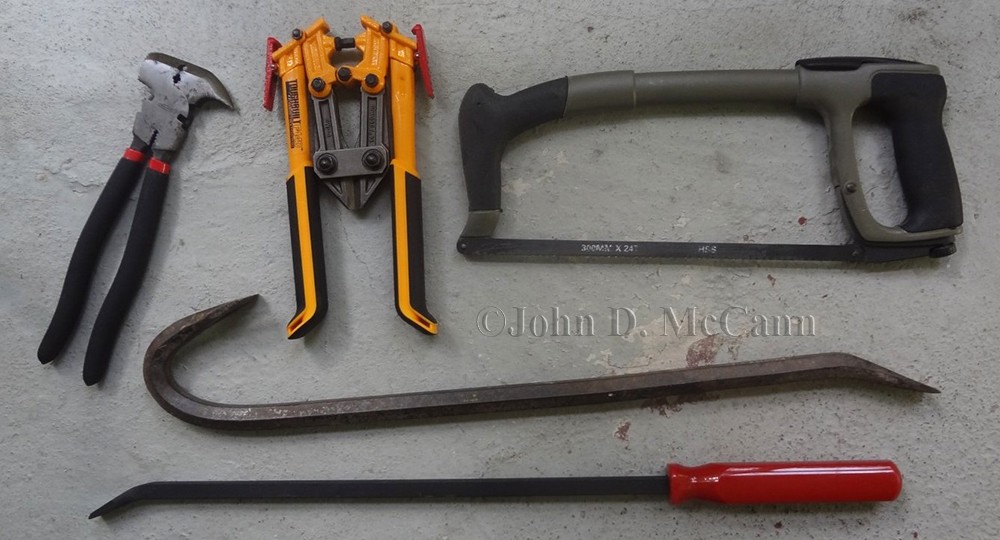 Tools such as fence pliers, bolt cutters (shown, folded for storage), a hacksaw and pry bars are
Tools such as fence pliers, bolt cutters (shown, folded for storage), a hacksaw and pry bars are
handy tools to keep in a vehicle.
Keep Them Tires Rolling
Having at least one spare is essential. Many new cars today have a mini-tire and whenever room is available, I suggest replacing it with a real wheel and tire that matches the set on your vehicle.
There is a product for the emergency repair of a flat tire, called Fix-A-Flat Aerosol Tire Inflators. They are designed to seal small tire punctures and provide enough inflation to lift the rim off the ground. It is designed only to provide a temporary emergency repair that will allow you to safely travel to a tire repair facility. It is not designed as a permanent solution and will not repair sidewall or severe damage, large punctures, or rim leaks.
If you get a puncture, a simple tire-plug kit can get you back up and running. These kits are small and available at almost any auto parts store. The kit provides a tool that reams out the hole, tire plugs, a tube of rubber cement, and a tool that allows you to place the plug into the reamed hole. They are inexpensive and should be in every vehicle. Keep in mind they are for punctures in the tread only.
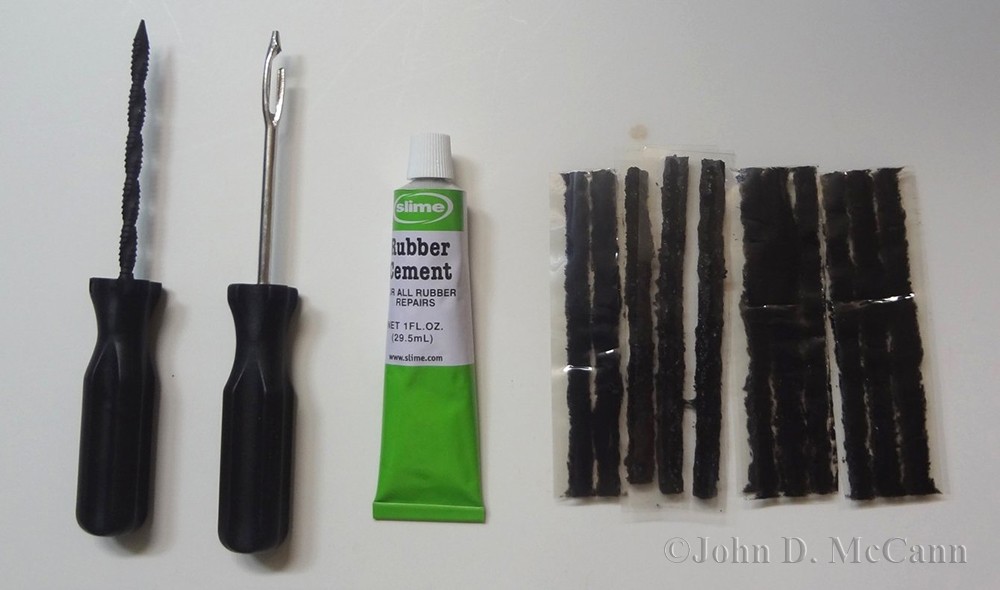 This photo shows a simple tire plug-kit that can be used to fix a punctured tire. You will need an air
This photo shows a simple tire plug-kit that can be used to fix a punctured tire. You will need an air
compressor, or Fix-A-Flat Aerosol Tire Inflator, to blow the tire back up.
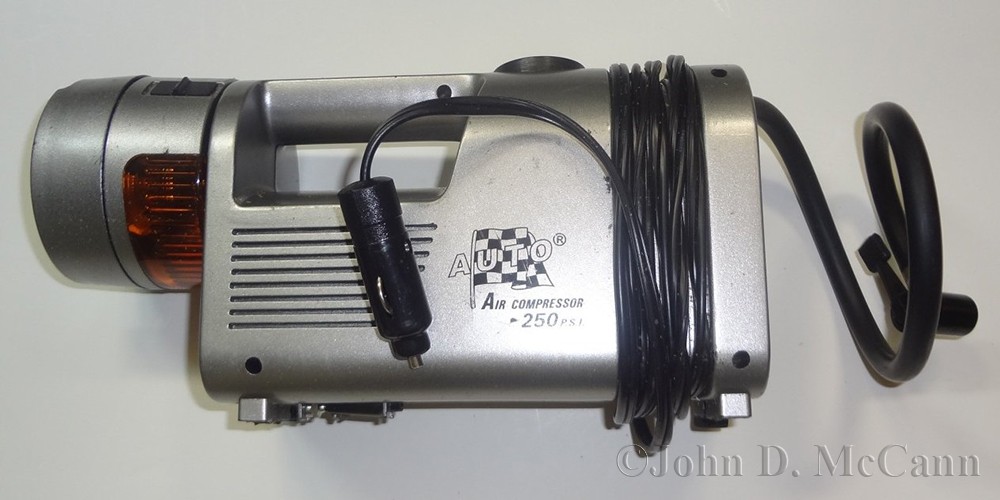 A small, inexpensive, 12 Volt air compressor gets its power from your vehicle through a cigarette lighter plug.
A small, inexpensive, 12 Volt air compressor gets its power from your vehicle through a cigarette lighter plug.
This one also has a telescoping flashlight and emergency flasher.
Another piece of equipment you should have is a small 12 volt air compressor. I have one in my truck, shown above, that also has a light on the front. The light can be used to light up the tire at night, and also has a yellow blinking light that can be raise up from the unit and used to warn others you are working on the vehicle. Very small and light, it stores under a seat.
Auxiliary Supplies
Having extra gas when you are evacuating or Bugging-out will allow you to drive further without needing a gas station to refill. This is especially important if the incident has caused gas stations to close.
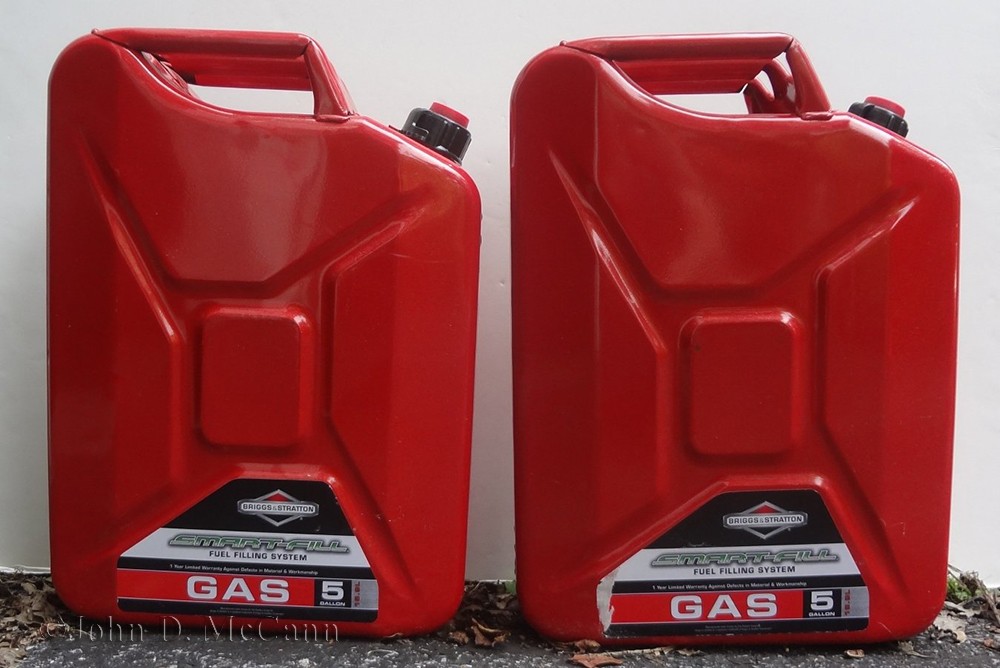 A couple of extra cans of gas can extend the distance you can travel, especially if gas isn't available.
A couple of extra cans of gas can extend the distance you can travel, especially if gas isn't available.
However, carrying them can be a problem.
Obviously, this is not always an easy task. If you have a car, you really can't carry extra containers of gas in the vehicle, and the same with an SUV or van. If you mount them to the outside, we have already discussed that it tells everybody you have extra gas. A difficult conundrum not easily solved. As I indicated earlier, if you have a pickup truck or a trailer, you can conceal the cans inside so they are not readily observed.
An option for pickup trucks is auxiliary fuel tanks. There are various manufacturers that make these types of tanks, and some even conceal them as tool boxes. However, most of them are only made for diesel fuel. Do a web search and you will find various configurations.
Obviously, this article isn't all inclusive of all things you could carry in your vehicle, but should provide you with food for thought in regard to keeping you Bug-Out vehicle rolling.
We hope you enjoyed this article and will help support our efforts by checking out our products. As always, Be Prepared To Survive!
Copyright © 2018 by John D. McCann
Note: Some of the information contained in this article was first published in my book "BUG-OUT - Reality Vs. Hype."


